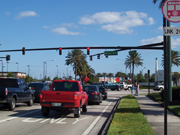U.S. Department of Transportation
Federal Highway Administration
1200 New Jersey Avenue, SE
Washington, DC 20590
202-366-4000
The leading cause of death for individuals ages one to 44 in the U.S. is motor vehicle crashes. Motor vehicle crashes place millions of people at risk for death or injury, disproportionately affect the young, and are the leading cause of lost years of productive life.
One way to prevent these crashes is by identifying locations with high crash rates or identifying crash patterns on specific roadway types and making safety improvements.
The Highway Safety Improvement Program (HSIP) provides funding to make those critical improvements. With a focus on results, the program emphasizes a data-driven, strategic approach to improving highway safety through infrastructure-related improvements.
The HSIP consists of the following programs:
Strategic Highway Safety Plan (SHSP) – A statewide-coordinated safety plan that provides a comprehensive framework for reducing highway fatalities and serious injuries on all public roads.
State Highway Safety Improvement Program – Identifies and corrects high crash locations and/or crash patterns on all public roads through infrastructure-related improvements. The states’ HSIP should address priorities identified in the SHSP.
High Risk Rural Roads Program – Identifies and supports improvements on rural roadways (major or minor collector roads or local roads) on which the rate for fatalities and incapacitating injuries exceeds the statewide average.
Railway-Highway Grade Crossing Program – Identifies and supports safety improvements at railway-highway crossing locations.
The Highway Safety Improvement Program (HSIP) is a roadway safety management process administered at the state, regional, or local level. The HSIP consists of processes for planning, implementation, and evaluation and involves four basic steps – analyze the data, identify appropriate countermeasures, prioritize and select projects, and evaluate results.
Data provide evidence that a safety improvement is needed. Crash data is the most common safety data source; however, agencies also use other data sources including, but not limited to, traffic volume, citation/adjudication data, or information from law enforcement and emergency medical services. The data are analyzed to identify the following:
Crash patterns that can be addressed with systemic improvements or ones that can be applied on roadways that share a common safety problem; and/or
Sites with potential for safety improvement.
This process helps agencies visualize, examine, explain, and predict the occurrence of motor vehicle crashes. The SHSP uses a data driven approach to identify the state’s most serious transportation safety issues, and the findings of the SHSP data analysis may be a good starting point to guide the HSIP problem identification process. For example, if Intersection Safety is an emphasis area in the state SHSP, HSIP planners can obtain the data that has already been collected and further analyze them to identify the sites with potential for safety improvement.
 Once potential sites have been identified, the next step involves selecting the right countermeasure that will improve safety. The following tasks describe how to select appropriate countermeasures:
Once potential sites have been identified, the next step involves selecting the right countermeasure that will improve safety. The following tasks describe how to select appropriate countermeasures:
Identify the factors that contributed to the crash such as the design of the roadway, problems with the vehicle, the behavior of the road user, and any environmental elements;
Conduct engineering studies and road safety audits (RSAs) that will further explain the nature and extent of the safety problem through data analysis, and an assessment of conditions or hazards; and
Assess the effectiveness of potential countermeasures by reviewing the research or examining the strategies and countermeasures in the SHSP.
Consideration should also be given to other road safety solutions beyond engineering countermeasures that can help improve safety such as high visibility enforcement or public outreach and education.
It is not possible to implement every project due to limited resources. Consequently, agencies must prioritize projects based on the overall cost of the countermeasure, its expected effectiveness, and expected service life. The purpose of the prioritization process is to ensure that the maximum safety benefit (i.e., lives saved) will be obtained for the amount of funds invested.
All countermeasures are not created equal particularly when it comes to cost. For instance, the department of transportation has identified a site experiencing a high number of run-off-the road crashes. After reviewing the data and conducting a RSA, the major problem is a tight curve in a roadway. Two effective approaches are considered: one would be to straighten the roadway and eliminate the curve and another is to install curve warning signs and rumble strips to alert motorists to the hazard. A comparison of cost and benefits reveals the second option can achieve the greatest safety benefit for the least cost.
 The ultimate measure of success for any roadway safety management program is a reduction in fatalities and serious injuries. It is important for agencies to know whether their HSIP meets this ultimate test and evaluation is the tool which transforms guesswork into certainty. The benefits of evaluation go beyond determining the effectiveness of an individual countermeasure. Evaluation can be also be used to determine the effectiveness of a single project or a group of projects, or to determine the effectiveness of an entire program.
The ultimate measure of success for any roadway safety management program is a reduction in fatalities and serious injuries. It is important for agencies to know whether their HSIP meets this ultimate test and evaluation is the tool which transforms guesswork into certainty. The benefits of evaluation go beyond determining the effectiveness of an individual countermeasure. Evaluation can be also be used to determine the effectiveness of a single project or a group of projects, or to determine the effectiveness of an entire program.
Evaluation ensures HSIP resources are used effectively, corrects deficiencies in the current program, and can be used to leverage additional resources.
These HSIP processes are discussed in the HSIP Manual, which provides information on topics ranging from core safety concepts to detailed discussions of technical methods for data-driven safety planning. Whether you are a new safety professional or have been working in the safety field for a number of years, the HSIP Manual is a comprehensive highway reference for state and local transportation safety practitioners working on HSIPs and safety projects.
A two-day workshop has also been developed that supplements the HSIP Manual. Workshop participants will learn new procedures and technologies for:
Workshop participants might include state and local transportation professionals in the areas of data collection and analysis, safety management processes, and planning and project management.
The HSIP Manual is available online at: http://safety.fhwa.dot.gov/hsip.
Copies of the HSIP Manual can be requested from FHWA’s report center at: report.center@dot.gov.
The workshop is available through the National Highway Institute. For more information, visit their web site at: http://nhi.fhwa.dot.gov.
For additional information related to the HSIP Manual or workshop, contact:
Karen Yunk, P.E.
Office of Safety
Federal Highway Administration
609-637-4207
karen.yunk@dot.gov or
http://safety.fhwa.dot.gov/hsip
Publication #: FHWA SA-09-030
